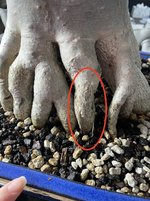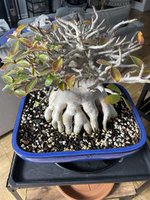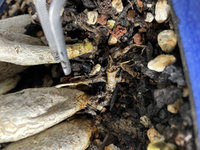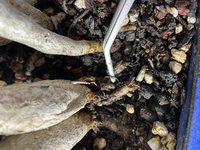You are using an out of date browser. It may not display this or other websites correctly.
You should upgrade or use an alternative browser.
You should upgrade or use an alternative browser.
How to save my desert rose?
- Thread starter Joyce2021
- Start date
Sansokuu
Chumono
- Messages
- 626
- Reaction score
- 1,872
Usually when the upper branches rot you pinch them off until you get to green flesh, then those heal over. I am not sure how to deal with rotting roots but it might be similar. When the upper branches soften and rot, the rot keeps spreading unless it is physically removed. These typically shouldn’t be watered in the winter time. The wet and cold makes for rot.
ZombieNick
Shohin
I would bare root this and cut out all the rot (make sure you get it all, cut more if you aren't sure). Seal the wounds with a fungicide (I just use cinnamon), and hang it in a dry spot for a week or two, until the wounds are completely healed over. Then replant.
Sansokuu
Chumono
- Messages
- 626
- Reaction score
- 1,872
This is good advice. And do not water when temps drop! They have those thick caudexes and can do awhile without water. Plus the dropped leaves mean it is kind of in dormancy, so again, no need for the water. What kind of mix is this? I typically use a custom cactus mix (no peat) but add in a lot of pumice for drainage.I would bare root this and cut out all the rot (make sure you get it all, cut more if you aren't sure). Seal the wounds with a fungicide (I just use cinnamon), and hang it in a dry spot for a week or two, until the wounds are completely healed over. Then replant.
El Tigre de Bonsai
Sapling
this doesn't look very severe yet but you need to stop watering it. Maybe go to 1 time per month. I might think about cutting the rotting parts off but i havent figured out if it spreads or not
El Tigre de Bonsai
Sapling
those are some crazy roots, i suppose you have many years with that tree?
When I repot the plant, should I water it or just leave it in the dry new soil?I would bare root this and cut out all the rot (make sure you get it all, cut more if you aren't sure). Seal the wounds with a fungicide (I just use cinnamon), and hang it in a dry spot for a week or two, until the wounds are completely healed over. Then replant.
Sansokuu
Chumono
- Messages
- 626
- Reaction score
- 1,872
No water!When I repot the plant, should I water it or just leave it in the dry new soil?
No, I bought it last May.those are some crazy roots, i suppose you have many years with that tree?
rollwithak
Chumono
Wow that is a beautiful desert rose. I can’t tell if that’s is it black lava BUT I’m thinking it looks WAY too wet for winter or for when it’s struggling for that matter. These should remain nearly dry most of the winter. This gal has a lot of useful information on desert roses. Good luck, save that beauty!
This video is super helpful!!! Thank you!Wow that is a beautiful desert rose. I can’t tell if that’s is it black lava BUT I’m thinking it looks WAY too wet for winter or for when it’s struggling for that matter. These should remain nearly dry most of the winter. This gal has a lot of useful information on desert roses. Good luck, save that beauty!
El Tigre de Bonsai
Sapling
you could water it when you repot to be safe, but im always seeing adenium get killed to over watering. You wouldn't think watering twice a week is overwatering, but if your soil isn't drained enough and it has been cloudy or it hasn't been really hot, the that water isn't drying up. just forget about these plants in the garden, and if you need comfort go look at weather spark to see how much rain they get during the year in their environment and try calculating that into your watering schedule. These are some of the driest places on earth where adenium come from.
ZombieNick
Shohin
If you gave it sufficient time and the wounds are completely healed over, then it should be safe to water. Your thread actually had me check my addenium. I overwinter in a greenhouse and one of my seedlings caught rot in the upper branches just from the humidity. I was confident the rot didn't reach the roots (I can't remember the last time I watered them), so a little different then your scenario, but here are some pics of the surgery.When I repot the plant, should I water it or just leave it in the dry new soil?
I had to cut off more than I had wanted to make sure I got ALL of the rot.
Similar threads
- Replies
- 9
- Views
- 774




